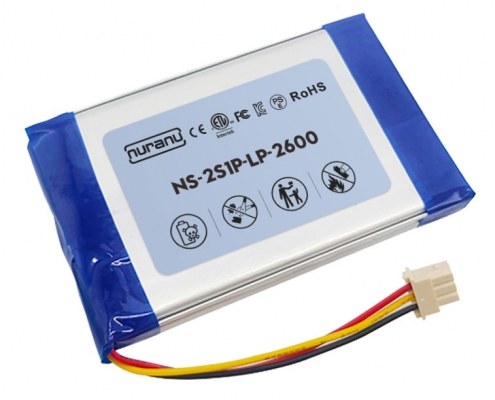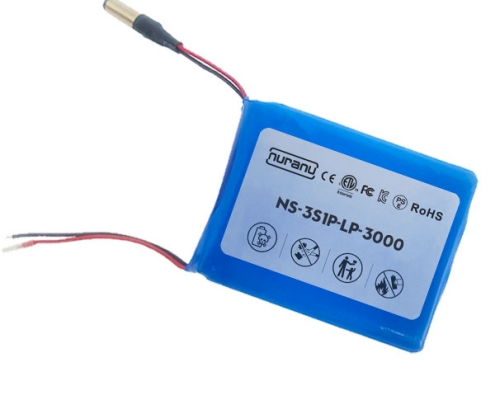
Nuranu is leading customized lithium polymer battery pack manufacturer, supplier from China, we develop, manufacture and sell lithium polymer battery pack for various industries. Our lithium polymer batteries can help to ensure your equipment running smoothly and take it to the next level. If you are looking for reliable lithium polymer battery pack factory in China, please don’t hesitate to contact info@nuranu.com .

What is lithium polymer battery
Li-polymer battery (Li-polymer), also known as lithium polymer battery. It is also a kind of lithium ion battery, but compared with liquid lithium battery (Li-ion), it has many obvious advantages such as high energy density, smaller size, ultra-thin, lighter weight, and high safety. In terms of shape, lithium polymer batteries have ultra-thin features, and can be made into battery packs of any shape and capacity to meet the needs of various products. The minimum thickness of lithium polymer battery can reach 0.5mm. Its nominal voltage is the same as Li-ion’s nominal voltage of 3.7V, and there is no memory effect.
Features of lithium polymer battery
- Shaping flexibility;
- Higher mass ratio energy (3 times that of MH-Ni batteries);
- The electrochemical stability is wide, up to 9V;
- Perfect safety and reliability;
- Longer cycle life and less capacity loss;
- High volume utilization;
How does polymer lithium battery work
At this stage, ion batteries are divided into liquid lithium batteries (LIB) and polymer lithium ion batteries (PLB). Among them, liquid lithium batteries refer to positive and negative pole batteries containing Li+ embedded chemical substances. Positive components LiCoO2, LiNiO2 or LiMn2O4, negative components LixC6, the typical rechargeable battery system is:
Positive electrode reaction (reduction reaction): Li1-xCoO2+xLi++xe-=LiCoO2
Negative reaction (redox reaction): LixC6-xe-=6C+xLi+
The total reaction of the lithium polymer battery pack: Li1-xCoO2+LixC6=Li-CoO2+6C
The principle of lithium polymer batteries is the same as that of liquid lithium-ion batteries, and the key difference depends on the difference in the electrolyte of the lithium battery. The key structure of the battery contains three elements: positive, negative and electrolyte solution. “Polymer lithium battery” refers to the rechargeable battery system software that uses polymer as the key structure in at least one or more of the three key structures here. And in the polymer lithium battery management system developed and designed at this stage, the application of polymer raw materials in the positive grade and lithium battery electrolyte is very important. The metal electrode contains conductive polymer materials or inorganic substances in general lithium batteries. The electrolyte solution can be solid or colloidal polymer material electrolyte solutions, or organic chemical lithium battery electrolytes. General lithium ion batteries are technically applied liquid bodies or colloidal solution lithium battery electrolyte, so it must be firmly repackaged to contain the flammable specific components, which not only increases the net weight, but also limits the coordination of specifications.
The new polymer lithium battery (ATL rechargeable battery is ultra-thin up to mm, which is equivalent to the thickness of a credit card), free total area and free appearance, greatly improving the coordination ability of rechargeable battery product design, and then you can consider product regulations , so that all kinds of rechargeable batteries have a larger volume, and show some design coordination capabilities and switching power supply solutions for equipment developers to maximize their product characteristics. In addition, the kinetic energy of high polymer lithium battery is 20% higher than that of general lithium batteries at this stage, and the volume and environmental protection characteristics are also gradually improved compared with general lithium batteries.
Package and structure requirements of lithium polymer battery
The polymer lithium battery is structured with aluminum-plastic soft packaging. Once a safety hazard occurs, the lithium polymer battery cell will only blow up. The following conditions should be met in terms of safety performance:
(1) Short circuit: no fire, no explosion
(2) Overcharge: no fire, no explosion
(3) Hot box test: no fire, no explosion (constant temperature of 150℃ for 10 minutes)
(4) Acupuncture: no explosion (use a Ф3mm nail to penetrate the battery)
(5) Plate impact: no fire, no explosion (10kg heavy object hits the battery from a height of 1 meter)
(6) Incineration: no explosion (gas flame grill the battery)
Advantage of polymer lithium batteries
- The working standard voltage of a single rechargeable polymer lithium battery is far higher than the working standard voltage of a nickel-hydrogen rechargeable battery and a nickel-cadmium rechargeable battery.
- The density is large, and its relative density is twice or a even higher than nickel-hydrogen rechargeable batteries or nickel-cadmium batteries.
- The life span of lithium polymer battery is small, the storage time is too long, and its volume damage is also small.
- Long life, all normal application cycle time of polymer lithium batteries can exceed 500 times.
- There is no memory effect, no need to empty the remaining power before the battery is charged, which is convenient to use.
- Excellent safety factor: The structure type of polymer lithium ion battery is made of aluminum-plastic soft packaging, which is different from the plastic shell of liquid lithium battery. Once there is a safety risk, the liquid lithium battery is very prone to explosion, and the maximum number of polymer lithium batteries can only cause blow up.
- The thickness is not large, and it can be made thinner: the thickness can be guaranteed to be below millimeters, which is suitable for current mobile phones.
- Lighter weight: The rechargeable battery using polymer material lithium battery electrolyte does not need a plastic case for external maintenance. Compared with the aluminum shell lithium battery of the same volume specification model, the polymer lithium battery is 20% lighter than the aluminum shell rechargeable battery.
- Large capacity: Compared with the aluminum rechargeable battery of the same specification and model, the polymer lithium battery has a volume of 10-15% higher. At this stage, the smartphones released on the market are all using polymer batteries.
- Low internal resistance: The internal resistance of the lithium polymer cell is smaller than that of the general liquid lithium battery, which greatly reduces the self-consumption of the rechargeable battery and increases the battery life on the mobile phone, and can completely connect with the international standard. The polymer lithium battery is suitable for high-current charging and discharging. It is an ideal choice for remote operation and is the most likely product to replace Ni-MH rechargeable batteries.
- Ability to customize the appearance: The manufacturer does not need to be limited to standard appearance design, and can make appropriate specifications with economic development according to customer satisfaction, the thickness of lithium batteries can be improved or reduced, and new lithium batteries can be developed and designed with high quality and low price and the mold cycle time is short. Some can even be customized according to the appearance of the mobile phone to flexibly use the indoor space of the rechargeable battery case, so as to increase battery power.
- Excellent charge and discharge characteristics: Compared with liquid electrolyte solutions, polymer lithium batteries use colloidal solution or electrolyte solutions, which have stable charge and discharge characteristics.
- The design scheme of the lithium battery protection board is very simple: when using high polymer raw materials, the lithium battery cell is not easy to catch fire and explode, and the lithium battery cell itself also has a sufficient safety factor, so the maintenance route design plan of the polymer lithium battery can be considered to remove PTC and circuit breaker, and save the cost of rechargeable battery.
Disadvantages of polymer lithium batteries
- The cost of rechargeable batteries increases, and the electrolyte of lithium batteries cannot be purified by system software.
- In order to maintain route manipulation, overcharging or overdischarging will destroy the intersection of compounds in the rechargeable battery, which will seriously harm the number of battery cycles.
Charging method of polymer lithium battery
At present, the charging method of polymer lithium battery generally adopts constant current and constant voltage charging: the battery is first charged with constant current, when the battery voltage rises to a certain value (4.2V), the voltage remains unchanged, and the current in the circuit drops to a very samll value and eventually tends to 0.
Precautions for the use of polymer lithium batteries
- It is forbidden to hit the battery with sharp parts;
- It is forbidden to transport or store polymer lithium batteries and metal objects together;
- It is forbidden to discard, drop, impact or bend the battery, and it is forbidden to hit battery with a hammer or step on the battery;
- It is forbidden to use metal objects such as wires to directly short-circuit the positive and negative electrodes of the battery;
- It is forbidden to short-circuit the positive electrode or negative electrode of the battery with the aluminum layer of the outer packaging aluminum-plastic film material of the battery pack;
- It is forbidden to disassemble the battery pack under any circumstances;
- It is forbidden to invade the battery into water or sea water, and the battery cell should not be damp;
- It is forbidden to use or place batteries near heat sources (such as hot water, heaters, etc.);
- It is forbidden to heat the battery or throw it into the water;
- It is forbidden to weld batteries directly;
- It is forbidden to charge the battery near a fire or in a very hot place;
- It is forbidden to put the battery in a microwave oven or high-pressure container;
- It is forbidden to use or leave the battery under high temperature (such as strong sunlight or very hot car) for a long time, otherwise it will cause the battery to overheat, catch fire, or function decline, and the life span will be reduced;
- If the electrolyte leaks and touches the skin or other parts, immediately rinse with clean water. If the electrolyte contacts the eyes, rinse with clean water immediately and seek a nearby doctor as soon as possible;
- It is forbidden to use damaged batteries, such as electrolyte leakage or batteries that dissipate the odor of electrolyte and should be kept away from fire sources to prevent the battery from catching fire or exploding.
Common sense when using polymer lithium battery
- The battery charger must be a charger with a constant current and constant voltage and a parallel charging function. The charging current should be less than 1.5A. The charging voltage loaded on the positive and negative electrodes of each cell during charging must not exceed 4.25V;
- Over-discharge of the battery will result in the loss of battery performance and function. Users should strictly ensure that the discharge termination voltage of each battery is ≥2.75V;
- In order to use the battery better and longer, the battery should be charged irregularly to maintain the voltage between 3.6V-3.9V per cell;
- The charging temperature of the battery should be 0-40℃, the discharge temperature should be -20-60℃, and the storage temperature should be 25±5℃;
- Strictly comply with the transportation of the battery under 10%-50% of the charge state;
Disposal of polymer lithium battery
When the battery is scrapped, it is recommended to cut the aluminum-plastic film of the battery with scissors and rinse it with clean water for one minute. After that, it can be disposed without pollution or be recycled by a special organization. Polymer lithium batteries manufactured by Nuranu can be recycled by the supplier or distributor.
How to purchase high-quality polymer lithium batteries
The key to the greater competitive advantage of polymer lithium batteries lies in their small size, relatively light weight, and convenient portability. They have become an ideal green energy source favored by buyers. When choosing polymer lithium batteries, they must be within the scientific and reasonable voltage capacity category. More and more buyers are pursuing perfect ultra-large capacity and ultra-high voltage. This idea and practice is completely wrong. It must be clear that the more energy accumulated in a limited volume, the harder it is to manage, and the higher the voltage and the greater the capacity, the greater the difficulty and failure rate of the protection circuit and the equalization circuit. In order to better match the equipment we use with the polymer lithium battery, it depends on the safety test certification of the polymer lithium battery as follows:
Under normal circumstances, first judge from the appearance of the external polymer lithium battery package logo, such as the manufacturer’s name, brand name or trademark, style setting, and battery should be labeled.
On the other hand, it is necessary to pass tests, such as impact, acceleration, vibration, thermal shock, thermal cycle test, and high-altitude simulation test, so that the sample battery does not explode or catch fire, and there must be no perforation or leakage.
Next, a charge-discharge test is required, which should be understood from the aspects of charge-discharge cycle, short-circuit test, abnormal charge test, mandatory discharge test, overcharge, etc.
At this stage, more and more polymer lithium battery manufacturers are required to have CE, UL certification marks when exporting batteries, indicating that they meet the standards of safety, hygiene, environmental protection and buyer protection, etc., which are necessary for products sold in the European and North America market. So we have to make strict judgments on the polymer lithium battery to ensure the strong protection brought by the use of the equipment, and avoid the abnormalities in the process of use.
About Us
Founded in 2012, Nuranu is a high-tech enterprise specializing in developing, manufacturing, marketing and serving of rechargeable battery packs products and accessories.
Contact Us
- E-mail: info@nuranu.com
- Phone: +86-769-81010510
- Mobile: +86-13823274651
- Address: Room 301, 2nd Building, No. 55, Shikeng Road, Hengli Town, Dongguan, Guangdong Province, China
Nuranu Wechat















